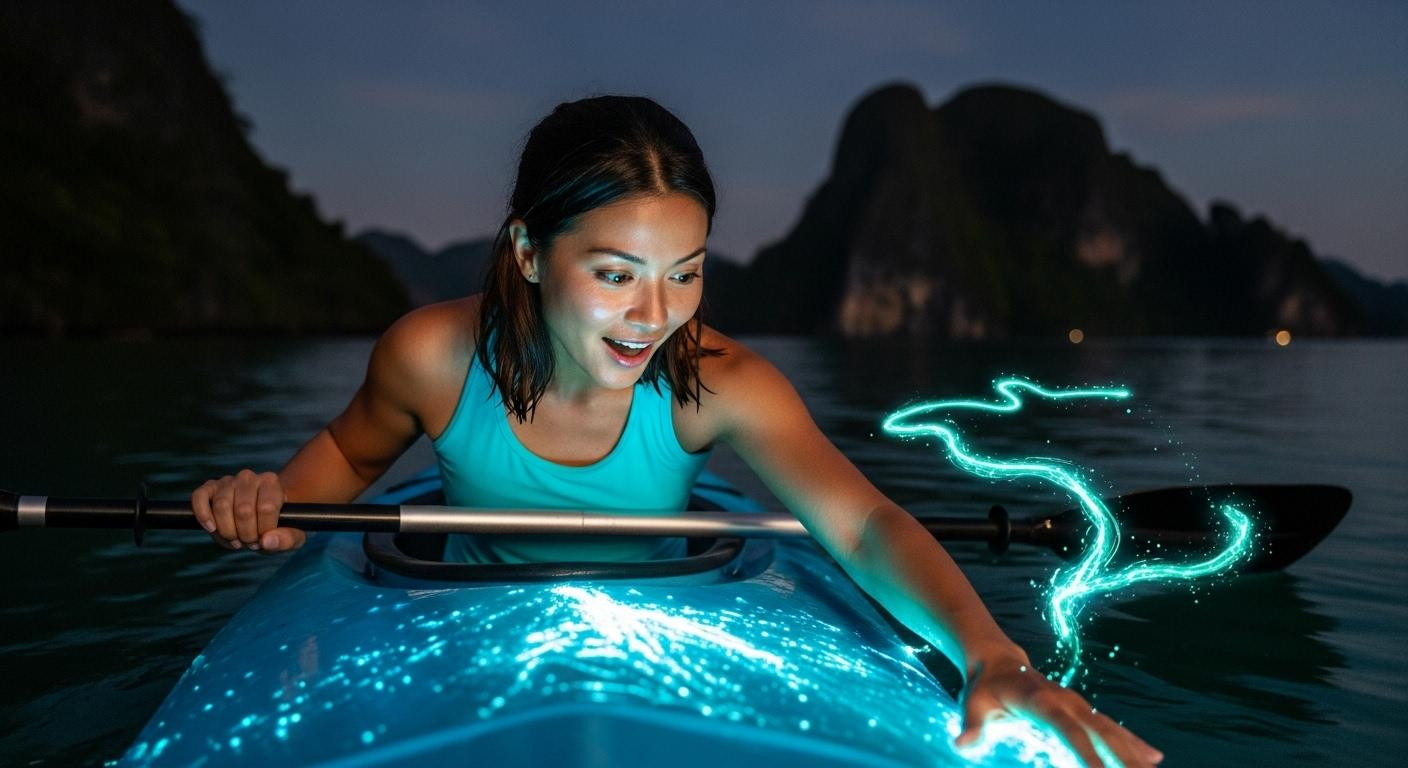Your paddle dips into Phang Nga Bay at 9:47 PM, and the water explodes in electric blue-green sparks. Each movement creates constellations beneath your kayak while limestone karsts tower silent overhead. Three nights ago, you knew bioluminescence existed theoretically. Now, trailing your hand through warm Andaman water, watching living light ripple from your fingertips, something fundamental shifts in how you understand darkness itself.
The night Thailand’s waters reveal their secret
The longtail boat cuts its engine 2 miles from Railay Beach. Guides distribute kayaks under starlight, their headlamps the only artificial glow for miles around. This is Ao Phang Nga National Park at its most protected: no resort lights, no cruise ships, just 8 paddlers entering mangrove channels where dinoflagellate plankton have thrived since the park’s establishment in 1981.
Water temperature holds steady at 79°F in late October. The limestone cliffs that made this region famous in daylight now create perfect darkness for bioluminescence visibility. Thailand’s southern islands maintain tropical warmth year-round, but few tourists discover this nighttime phenomenon.
Local tourism boards confirm November through April offers optimal viewing conditions. Clear skies, minimal rainfall, and calm seas create the perfect environment for plankton activity.
Why this glow changes what darkness means
The first paddle stroke reveals the magic. Electric blue-green trails follow your movement like liquid lightning. This isn’t artificial light or camera trickery. These microscopic organisms produce bioluminescence as a defense mechanism when disturbed.
The living light beneath your paddle
Dinoflagellate plankton generate light through a chemical reaction involving luciferin and luciferase. Each disturbance in the water triggers millions of these tiny organisms simultaneously. The darker the night, the more intense the glow appears to human eyes.
Museum exhibits in nearby Krabi demonstrate how this phenomenon differs from phosphorescence or artificial lighting. The blue-green spectrum peaks at exactly 475 nanometers, creating that otherworldly electric appearance.
The silence that amplifies wonder
No engine noise, no crowds, no artificial pollution. Just the gentle splash of paddles and occasional night bird calls. This pristine environment exists because Phang Nga Bay restricts motorboat access after sunset.
Tour groups average 8-12 people maximum, compared to 40-person day trips. Water-based experiences with limited visitor numbers preserve both ecosystem health and visitor intimacy.
What three hours in glowing water actually does
Recent visitor surveys conducted in 2025 reveal consistent emotional responses. Initial skepticism transforms into wonder within 30 minutes of paddling through bioluminescent waters.
The first 30 minutes: disbelief to immersion
Most paddlers attempt photography initially, but phone cameras struggle with low-light bioluminescence. Guides recommend waterproof cases but emphasize direct experience over documentation. The moment visitors stop trying to capture the glow and start experiencing it marks the transformation.
Eye adaptation to complete darkness takes approximately 20 minutes. Once adjusted, the bioluminescent trails become dramatically more visible and emotionally impactful.
The final hour: changed perception
Floating silently through limestone caves lit only by disturbed plankton creates lasting perspective shifts. Protected water environments offer similar transformative kayaking experiences, but Thailand’s combination of bioluminescence and dramatic karst topography proves uniquely powerful.
Tour operators report that 15% of participants return for repeat experiences. This differs significantly from typical tourist attractions where novelty drives single visits.
The dawn after: what remains
Sunrise over the same waters hours later creates full-circle understanding. The limestone cliffs that created perfect darkness now glow golden in morning light. The water appears ordinary again: turquoise, peaceful, normal.
But you know what it holds after dark. That knowledge changes how you perceive natural phenomena everywhere. Night swimming will never feel the same. October travel to protected destinations often provides these profound, uncrowded experiences.
Your questions about kayaking Thailand’s bioluminescent waters answered
When does Thailand’s bioluminescence peak and what’s the real cost?
November through April offers optimal viewing with 85% clear night success rates. Tours cost $80-110 including transport, dinner, and equipment. National park fees add $6 per adult, $3 per child. International flights average $700-1200 from major US cities, making total trip costs competitive with domestic alternatives.
How do you actually respect this ecosystem while experiencing it?
Choose operators limiting groups to 8-12 paddlers maximum. Never touch plankton despite temptation: skin oils can damage these delicate organisms. Certified eco-tour guides emphasize minimal environmental impact protocols established by Thailand’s National Park Service. Small group size preserves both ecosystem health and experience quality.
Is this better than Puerto Rico’s Mosquito Bay or Maldives’ glow?
Thailand’s limestone karst setting adds dramatic visual context absent in other locations. Costs run 25% less than comparable Caribbean bioluminescent tours. Cultural depth and accessibility surpass Maldives’ resort-restricted experiences. The combination of geological drama and marine phenomena creates uniquely transformative conditions.
Steam rises from your morning tea at a Koh Yao Yai beachfront café. Last night’s electric blue glow lingers in memory as dawn light touches the same limestone cliffs. The water looks ordinary now, turquoise and peaceful. But you know what it holds after dark, and that changes everything.
